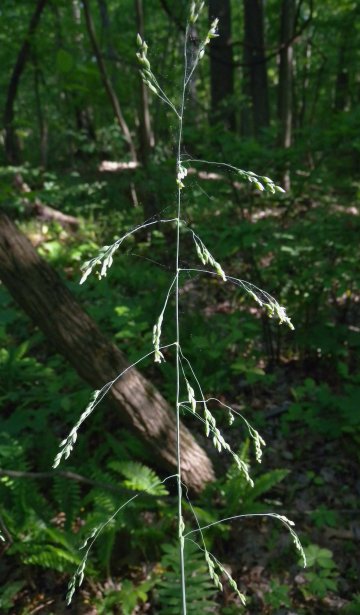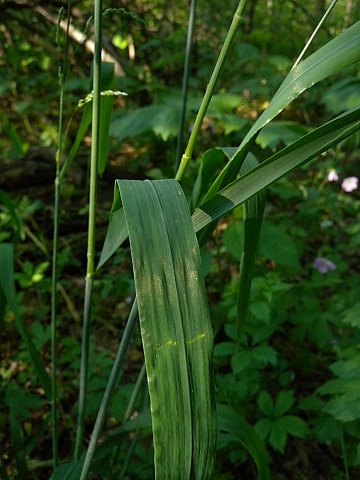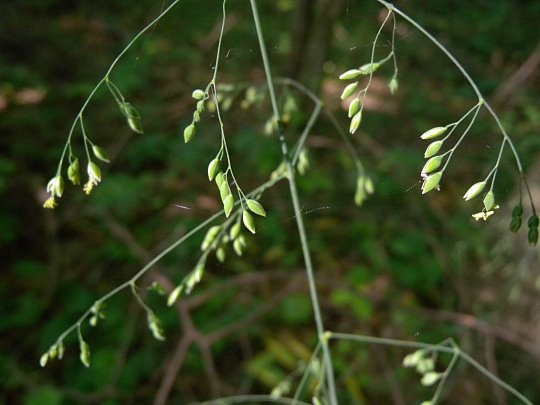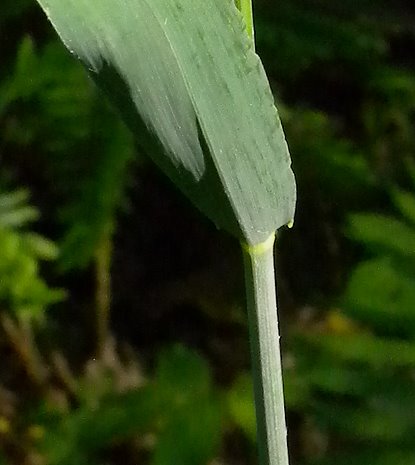
Along the central stalk (or axis) of the panicle, there are whorls of 2-6 lateral branches (up to 4" in length) that individually subdivide into 1-4 whorled branchlets. However, toward the apex of the central axis, there are usually a few alternate branches. Both the branches and branchlets are widely spreading to drooping; they are light gray-green and glabrous to minutely short-pubescent. Individual spikelets occur along the branchlets on short pedicels up to 5 mm. long. These spikelets are 2.5-4.0 mm. long, ellipsoid in shape, glabrous, and single-flowered; they are light green while immature, becoming tan to brown at maturity. Each spikelet consists of a pair of outer glumes, a single lemma with a palea, and a perfect floret. The equal-sized glumes are the same length as the spikelets, elliptic-ovate in shape, 3-veined, and convex along their outer sides; they have white-membranous margins. The glumes enclose and hide a slightly smaller lemma and palea. There are 3 stamens with pale yellow anthers and a pair of white feathery stigmata; the anthers are 1.5-2.0 mm. long. The blooming period occurs during late spring or early summer. When the spikelets become mature, they disarticulate above the glumes. The grains are about 2.0-3.0 mm. long, 1 mm. across, and ellipsoid in shape. The root system is fibrous.

Cultivation: The preference is partial sun to medium shade, moist conditions, and soil containing muck, loam, clay-loam, or sandy loam. This cool-season grass develops quickly during the spring.
Range & Habitat: The native Millet Grass has been found in only 3 counties of Illinois (see Distribution Map); it is rare within the state and state-listed as 'endangered.' Illinois lies along the southwestern range limit of this grass. In addition to northeastern North America, it also occurs in Eurasia. Habitats consist of wet to mesic woodlands (including sandy woodlands), woodland openings, flatwoods in upland moraines, seeps and springs in wooded areas, areas along woodland paths, and sedge meadows. In Illinois, Millet Grass is found in higher quality natural areas. It is found in deciduous woodlands within the state, although it also occurs in mixed woodlands outside of the state.

Faunal Associations: Little is known about floral-faunal relationships for this species. The foliage is regarded as good forage for hoofed mammalian herbivores (cattle, horses, sheep, etc.).
Photographic Location: Along a path in a moist sandy woodland at the Indiana Dunes State Park in NW Indiana.

Comments: This is one of the tallest woodland grasses during the spring and early summer. It usually occurs as scattered plants, rather than in dense colonies. Because of its size and general appearance, Millet Grass superficially resembles Stout Wood Reed (Cinna arundinacia), but the latter is slower to develop and its spikelets disarticulate below the glumes. Because of its single-flowered ellipsoid spikelets, Millet Grass also resembles some panic grasses (Panicum spp.), but the latter have spikelets with unequal-sized glumes. Unlike Millet Grass, the smaller glumes of panic grasses are much shorter than their spikelets. In addition to these grasses, Millet Grass should not be confused with cultivated millet, which refers to several grasses of the Old World. Some of the most common cultivated millets include Pearl Millet (Pennisetum glaucum), Proso Millet (Panicum miliaceum), Foxtail Millet (Setaria italica), and Japanese Millet (Echinochloa esculenta). Other common names of Milium effusum include Tall Millet Grass and Wood Millet. This is the only grass species of this genus in Illinois.